UNOFFICIALWELCOMEPACKAGE32917 (PDF)
File information
Author: GTAPC
This PDF 1.6 document has been generated by Acrobat PDFMaker 11 for Word / Adobe PDF Library 11.0, and has been sent on pdf-archive.com on 30/03/2017 at 10:30, from IP address 174.119.x.x.
The current document download page has been viewed 365 times.
File size: 4.49 MB (188 pages).
Privacy: public file
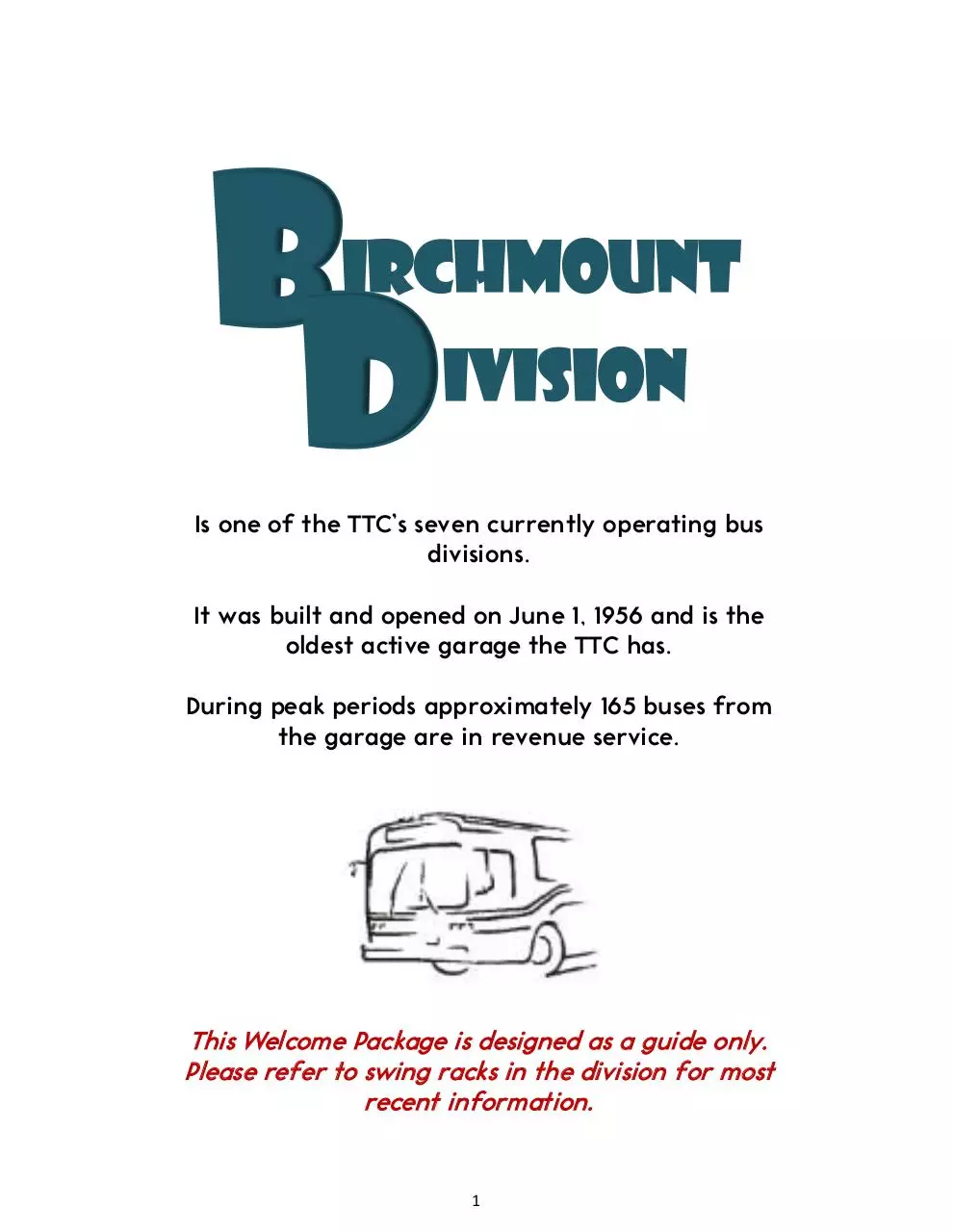
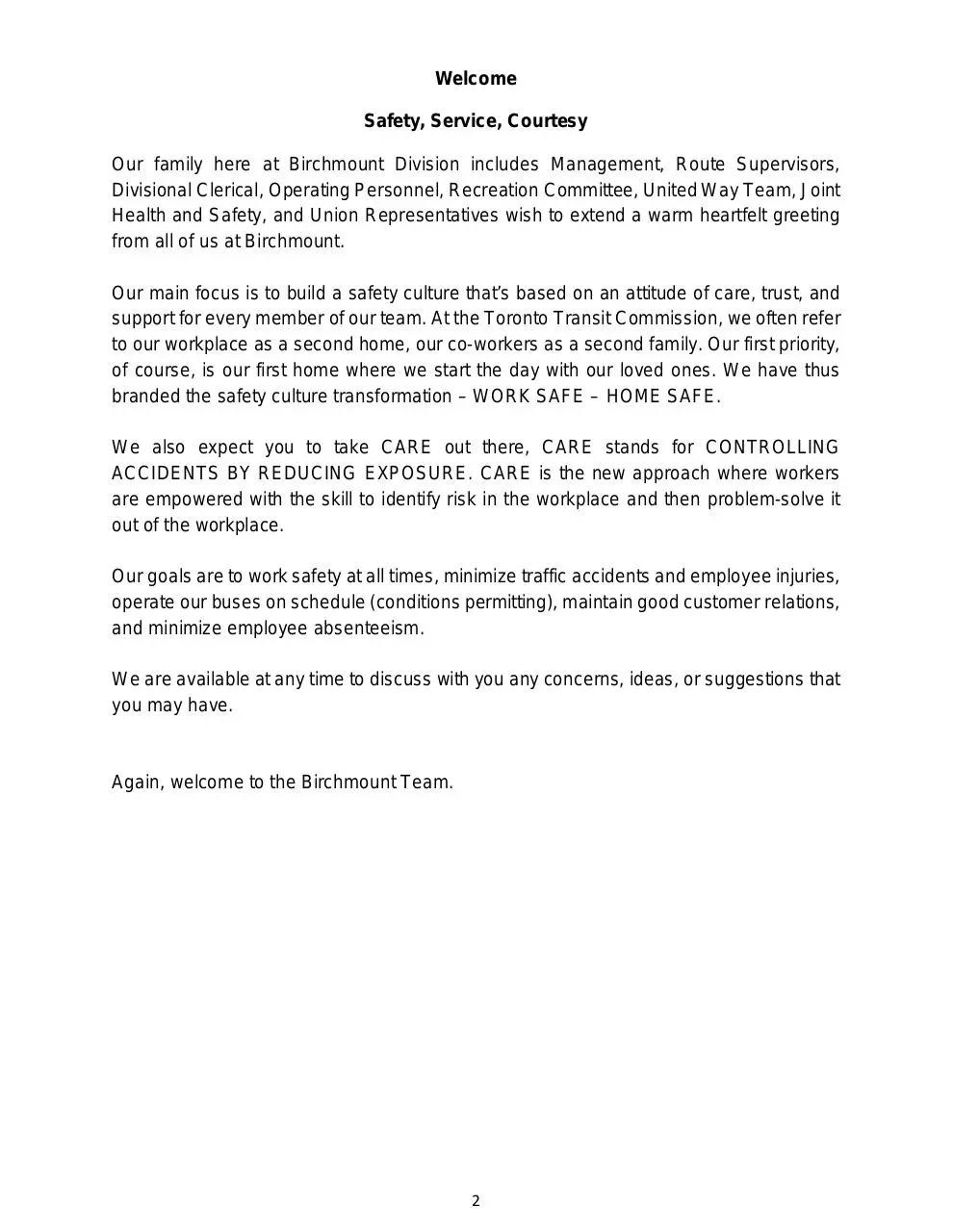
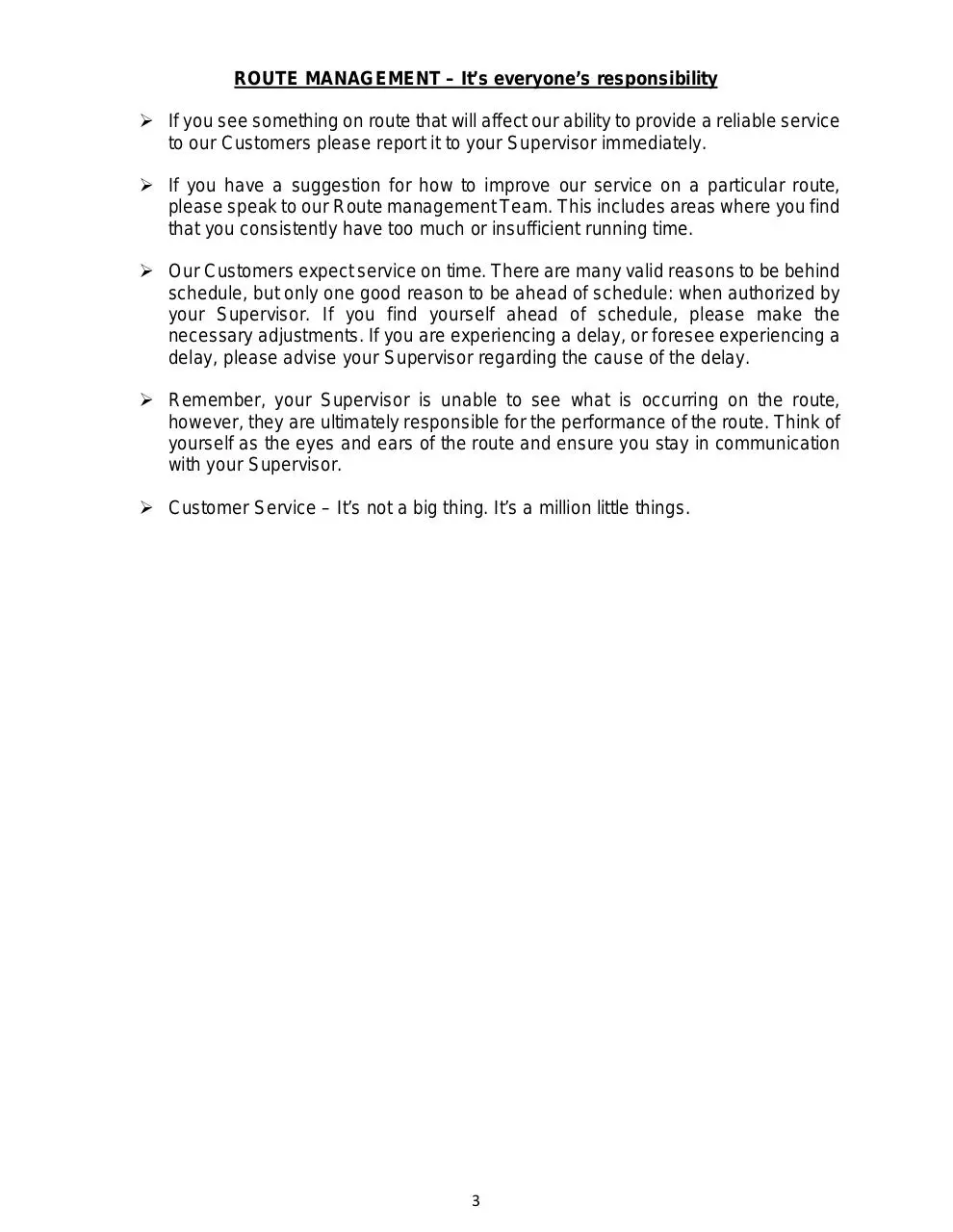
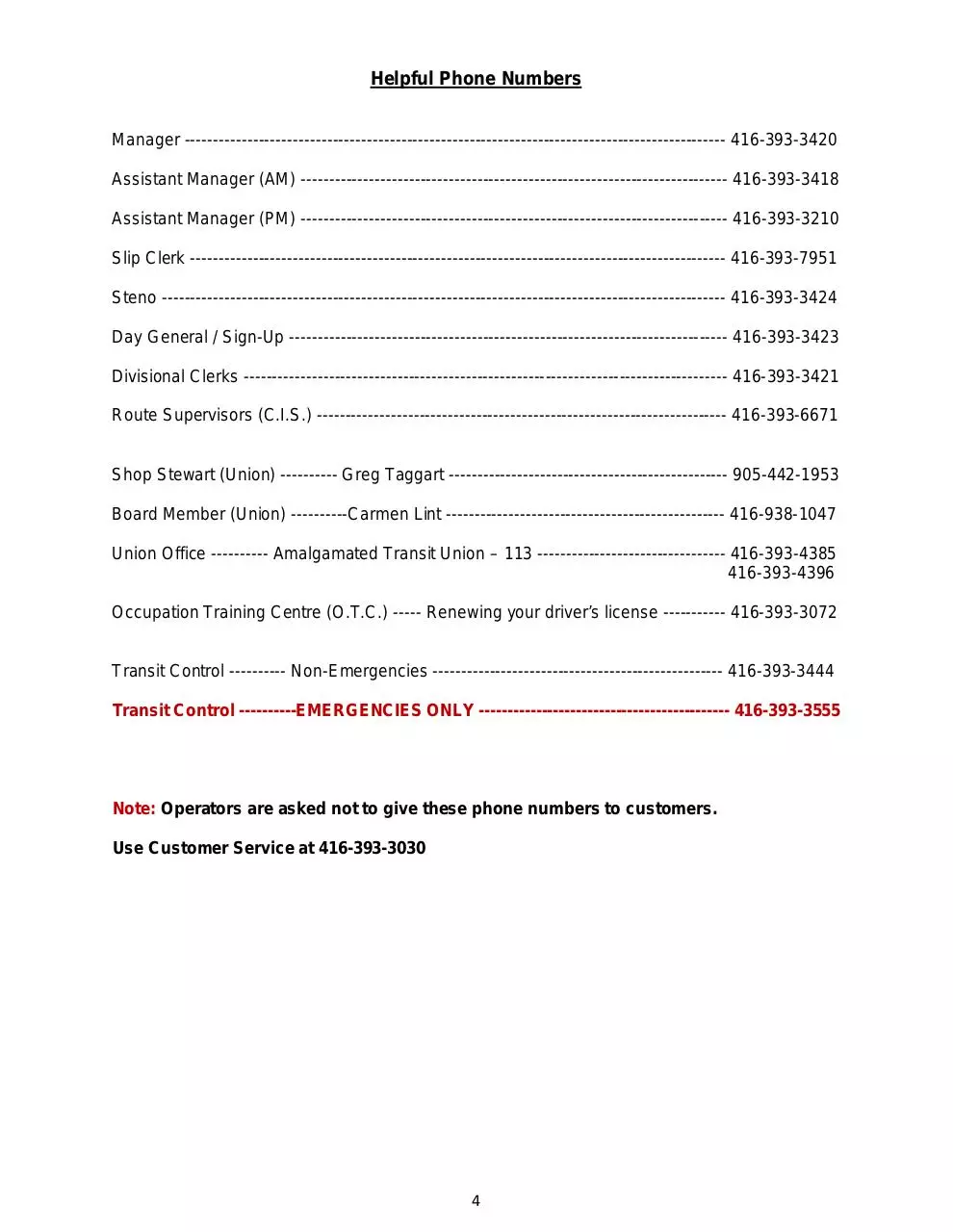

File preview
B
D
IRCHMOUNT
IVISION
Is one of the TTC’s seven currently operating bus
divisions.
It was built and opened on June 1, 1956 and is the
oldest active garage the TTC has.
During peak periods approximately 165 buses from
the garage are in revenue service.
This Welcome Package is designed as a guide only.
Please refer to swing racks in the division for most
recent information.
1
Welcome
Safety, Service, Courtesy
Our family here at Birchmount Division includes Management, Route Supervisors,
Divisional Clerical, Operating Personnel, Recreation Committee, United Way Team, Joint
Health and Safety, and Union Representatives wish to extend a warm heartfelt greeting
from all of us at Birchmount.
Our main focus is to build a safety culture that’s based on an attitude of care, trust, and
support for every member of our team. At the Toronto Transit Commission, we often refer
to our workplace as a second home, our co-workers as a second family. Our first priority,
of course, is our first home where we start the day with our loved ones. We have thus
branded the safety culture transformation – WORK SAFE – HOME SAFE.
We also expect you to take CARE out there, CARE stands for CONTROLLING
ACCIDENTS BY REDUCING EXPOSURE. CARE is the new approach where workers
are empowered with the skill to identify risk in the workplace and then problem-solve it
out of the workplace.
Our goals are to work safety at all times, minimize traffic accidents and employee injuries,
operate our buses on schedule (conditions permitting), maintain good customer relations,
and minimize employee absenteeism.
We are available at any time to discuss with you any concerns, ideas, or suggestions that
you may have.
Again, welcome to the Birchmount Team.
2
ROUTE MANAGEMENT – It’s everyone’s responsibility
If you see something on route that will affect our ability to provide a reliable service
to our Customers please report it to your Supervisor immediately.
If you have a suggestion for how to improve our service on a particular route,
please speak to our Route management Team. This includes areas where you find
that you consistently have too much or insufficient running time.
Our Customers expect service on time. There are many valid reasons to be behind
schedule, but only one good reason to be ahead of schedule: when authorized by
your Supervisor. If you find yourself ahead of schedule, please make the
necessary adjustments. If you are experiencing a delay, or foresee experiencing a
delay, please advise your Supervisor regarding the cause of the delay.
Remember, your Supervisor is unable to see what is occurring on the route,
however, they are ultimately responsible for the performance of the route. Think of
yourself as the eyes and ears of the route and ensure you stay in communication
with your Supervisor.
Customer Service – It’s not a big thing. It’s a million little things.
3
Helpful Phone Numbers
Manager ----------------------------------------------------------------------------------------------- 416-393-3420
Assistant Manager (AM) --------------------------------------------------------------------------- 416-393-3418
Assistant Manager (PM) --------------------------------------------------------------------------- 416-393-3210
Slip Clerk ---------------------------------------------------------------------------------------------- 416-393-7951
Steno --------------------------------------------------------------------------------------------------- 416-393-3424
Day General / Sign-Up ----------------------------------------------------------------------------- 416-393-3423
Divisional Clerks ------------------------------------------------------------------------------------- 416-393-3421
Route Supervisors (C.I.S.) ------------------------------------------------------------------------ 416-393-6671
Shop Stewart (Union) ---------- Greg Taggart ------------------------------------------------- 905-442-1953
Board Member (Union) ----------Carmen Lint ------------------------------------------------- 416-938-1047
Union Office ---------- Amalgamated Transit Union – 113 --------------------------------- 416-393-4385
416-393-4396
Occupation Training Centre (O.T.C.) ----- Renewing your driver’s license ----------- 416-393-3072
Transit Control ---------- Non-Emergencies --------------------------------------------------- 416-393-3444
Transit Control ----------EMERGENCIES ONLY -------------------------------------------- 416-393-3555
Note: Operators are asked not to give these phone numbers to customers.
Use Customer Service at 416-393-3030
4
Security Procedures for Surface Operators
Role of Surface Operators as TTC Safety Partner
The TTC recognizes the need to provide a safe secure transit environment for its employees and
customers.
To reduce the risk of personal injury, physical involvement with matters involving threatening or
violent behaviour is strongly discouraged.
As TTC Safety Partners, Surface Operators are expected to initiate TTC response and/or
emergency assistance via Transit Control/C.I.S. when confronted with:
1. Persons in need of assistance or protection;
2. Safety hazards;
3. Threatening/criminal behaviour.
Operators are expected to resolve TTC By-Law No. 1 offenses, if it is safe to do so.
Operators should request direction from Transit Control/C.I.S. when assistance is required.
Proper response to TTC By-Law No. 1 Infractions
1. If it is safe to do so, advise the offender that the TTC prohibits the activity they are involved
in.
2. Request that they comply with the By-Law.
3. Direct their attention to the posted Public Notice (This will deflect attention away from you
and back to the TTC).
If the offender refuses to comply or if they become uncooperative;
4. Notify Transit Control/C.I.S. of the problem (Yellow Alarm, 3444 PAX, or 393-3444 Bell)
providing:
a. Exact location of problem (give run number, location and direction of travel);
b. Nature and extent of problem;
c. Employee number and vehicle number, when requested.
5. Assess the situation to determine appropriate response action in conjunction with Transit
Control/C.I.S.
6. If unable to notify Transit Control/C.I.S. and your safety is at risk (e.g. you have been
assaulted), activate the appropriate alarm and follow appropriate security procedures.
7. Assist TTC and Emergency personnel as required.
8. Submit an Occurrence report upon completion of duties.
5
Security Procedures for Surface Operators…cont.
Proper response to security incident, threatening/criminal behaviour, persons or property
in need of protection
Upon discovery or being notified of a security incident, threatening or criminal behaviour, or
persons or property in need of protection the Operator shall:
1. Notify Transit Control/C.I.S. (Yellow Alarm) of the emergency situation providing;
a. Exact location of problem (give run number, location and direction of travel);
b. Nature and extent of emergency;
c. Assessment of injuries, property damage;
d. All significant changes occurring at the scene;
e. Employee number and vehicle number, when requested.
Note: Pull over to the curbside and open all doors.
2. Assess the situation to determine appropriate emergency response action in conjunction
with Transit Control/C.I.S. and/or the TTC Emergency Response Commander.
3. Do not approach the offender.
4. Assist TTC and Emergency personnel as required.
5. If possible, secure the names of any witnesses both on the vehicle and on the street.
6. If injuries are involved do not move the vehicle until cleared by a Police Officer.
7. Submit an Occurrence report upon completion of duties.
Proper technique to wake a sleeping customer
In response to a sleeping customer en-route or at the end of a route:
1. Stand in a location so that you are:
a. Within sightlines of the customer, and;
b. A safe distance away from the sleeping customer (at least 4 feet).
2. Wake the customer by using a loud, clear, non-threatening tone of voice;
3. If the vehicle is going ‘Out of Service’ advise the customer that they must leave the vehicle.
Sample: “Excuse me Sir/Madam. This vehicle is out of service. You have to leave the vehicle.”
4. If the customer does not wake up, clap your hands while repeating your statement.
6
Security Procedures for Surface Operators…cont.
Proper technique to wake a sleeping customer
5. Do Not touch the customer.
6. If the customer fails to wake up, request assistance from the Route Supervisor, if on scene.
If necessary, call Transit Control/C.I.S. (Yellow Alarm) and follow their instructions.
Proper response to personal life threatening situation
If confronted with a personal life threatening situation resulting from crime (robbery, hostage
situation, etc.) the Operator shall:
1. Remain calm and satisfy the culprit’s demands.
2. Do not say or do anything to provoke a physical altercation.
3. When it is safe to do so, activate ‘Silent Red Alarm’ and notify Transit Control/C.I.S. of the
emergency situation and maintain an open line providing:
a. Exact location of problem (give run number, location and direction of travel);
b. Nature and extent of emergency;
c. Assessment of injuries, property damage;
d. All significant changes occurring at the scene;
e. Employee number and vehicle number, when requested.
4. If possible, note and advise Transit Control/C.I.S. of offender description(s), escape route,
witness information, etc.
5. Do not approach the offender.
6. If possible, encourage witnesses to remain on scene.
7. Protect the crime scene. Avoid touching or disturbing areas contacted by the culprit.
8. Submit an Occurrence report upon completion of duties.
Note: All TTC employees are strictly prohibited from possessing personal defense items such as
pepper spray or anything designed to be used or intended for use in causing injury to any person
while working.
7
Security Procedures for Surface Operators…cont.
Proper assessment and communication of Emergency situations to Transit Control/C.I.S.
In order to ensure effective assessment and communication of emergency situations to Transit
Control/C.I.S., the Operator shall:
1. Determine and communicate the exact location of the emergency.
•
This can normally be obtained through observation or communication with the
person reporting the problem.
•
Using simple terms, advise Transit Control/C.I.S. of the location.
•
To describe a specific vehicle, advise of the run number, location of the vehicle
and direction of travel.
Example: “7 Run, Bathurst, vehicle #5555, southbound at Eglinton Avenue.”
2. Determine and communicate the nature and extent of emergency/problem.
•
Carefully observe what is happening or effectively communicate with the person
reporting the problem to determine details.
•
Using simple terms, advise Transit Control/C.I.S. of the problem.
•
Describe what event has happened and what the status is, i.e. life threatening
situation, serious personal injury, major property damage, etc.
•
If Transit Control/C.I.S, requires more information to enable them to prioritize the
call, carry out their instructions. Do not imperil your own safety by doing so. If it is
not safe to obtain more information, advise Transit Control/C.I.S.
•
The additional information they request may be required to enable them to
determine the appropriate level of response, i.e. number of people required from
each Emergency Response Agency. The requirement to get additional information
does not mean that they have not already called 9-1-1.
Self Defense
The TTC strongly discourages Operators from becoming physically involved with security matters
involving threatening or violent behaviour.
In some cases, Operators may be required to use force to defend themselves against on
unprovoked assault.
The Criminal Code of Canada justifies the use of force for self-defence. Operators using force for
self-defence must ensure that the law is adhered to.
8
Security Procedures for Surface Operators…cont.
Self Defence
Self-defence against unprovoked assault – Extent of Justification.
34.(1) Everyone who is unlawfully assaulted without having provoked the assault is
justified repelling force by force if the force he uses is not intended to cause death or
grievous bodily harm and is no more than is necessary to enable him to defend himself.
34.(2) Everyone who is unlawfully assaulted and who causes death or grievous bodily
harm in repelling the assault is justified if.
a) He causes it under apprehension of death or grievous bodily harm from the
violence with which the assault was originally made or with which the assailant
pursues his purpose: and
b) He believes, on reasonable grounds, that he cannot otherwise preserve himself
from death or grievous bodily harm.
Preventing assault – Extent of Justification
37.(1) Everyone who is justified in using force to defend himself or anyone under his
protection from assault, if he uses no more force than is necessary to prevent the assault
or the repetition of it.
37.(2) Nothing in this section shall be deemed to justify the willful infliction or any hurt or
mischief that is excessive, having regard to the nature of the assault that the force used
was intended to prevent.
Proper response to victim of crime/harassment
When confronted with a victim of crime or harassment, the Operator shall:
1. Notify Transit Control/C.I.S, (Yellow Alarm) of the emergency and maintain an open line
providing:
a. Exact location of problem (give run number, location and direction of travel);
b. Nature and extent of emergency;
c. Assessment of injuries, property damage;
d. All significant changes occurring at the scene;
e. Employee number and vehicle number, when requested.
2. Assess the situation to determine appropriate emergency response with Transit
Control/C.I.S. and/or the TTC Emergency Response Commander.
3. Encourage the victim to stay in your presence or view until the arrival of emergency or
TTC Supervisory personnel.
9
Download UNOFFICIALWELCOMEPACKAGE32917
UNOFFICIALWELCOMEPACKAGE32917.pdf (PDF, 4.49 MB)
Download PDF
Share this file on social networks
Link to this page
Permanent link
Use the permanent link to the download page to share your document on Facebook, Twitter, LinkedIn, or directly with a contact by e-Mail, Messenger, Whatsapp, Line..
Short link
Use the short link to share your document on Twitter or by text message (SMS)
HTML Code
Copy the following HTML code to share your document on a Website or Blog
QR Code to this page
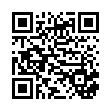
This file has been shared publicly by a user of PDF Archive.
Document ID: 0000576056.